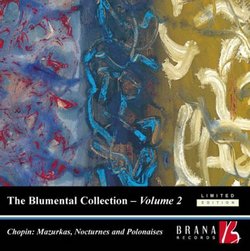| All Artists: Fryderyck Chopin, Felicja Blumental Title: The Blumental Collection Volume 2 - Chopin: Mazurkas, Nocturnes and Polonaises Members Wishing: 0 Total Copies: 0 Label: Brana Records Release Date: 5/22/2004 Genres: Dance & Electronic, Classical Style: Number of Discs: 1 SwapaCD Credits: 1 UPCs: 803680440353, 821158101827 |
Search - Fryderyck Chopin, Felicja Blumental :: The Blumental Collection Volume 2 - Chopin: Mazurkas, Nocturnes and Polonaises
 | Fryderyck Chopin, Felicja Blumental The Blumental Collection Volume 2 - Chopin: Mazurkas, Nocturnes and Polonaises Genres: Dance & Electronic, Classical
The mazurka is in fact both a French title and a translation of Poland?s native dance called a Mazurk. It is in triple time, either 3/8 or 3/4, (Chopin?s mazurkas were written in the latter) and often used church modes as... more » |
Larger Image |
CD Details
Synopsis
Album Description
The mazurka is in fact both a French title and a translation of Poland?s native dance called a Mazurk. It is in triple time, either 3/8 or 3/4, (Chopin?s mazurkas were written in the latter) and often used church modes as a source of harmony. The original folk mazurka is a combination of three dances, but is flexible to allow an improvisational section for new parts. For many of his compositions, Chopin turned to Polish folk music for inspiration. One of his favoured (and specialised) techniques is rubato and here it is ideal to convey the feeling of improvisation. Dotted rhythms and irregular accents are also characteristic of mazurkas and Chopin wrote with this particularly in mind. He combined these traditions with major and minor modes and extended this common dance to become a higher musical form and at the same time, captured the true spirit of the Mazurk. Chopin composed over 50 throughout his lifetime. A ?Nocturne? usually means an evening song that is soft in character, but Chopin developed this genre to incorporate a variety of moods with a more poetic and expressive nature, while adopting an A-B-A form. Section ?A? usually consisted of a dreamy bel-canto style and section ?B,? a more dramatic passage (a particular example of this is Op. 15, No 1). Here Chopin again turns to another dance form of his native land, Poland and takes its title from the peasant processional dances, Polski. As with the mazurka, it is in triple time, although Chopin adopts slower tempos and a more majestic quality. Chopin composed polonaises and waltzes throughout his lifetime. His first polonaise was composed at the age of 7 (Polonaise in G minor) and the last was Polonaise-Fantasie in A flat major Op. 61 dated in 1846. He applied many ideas to his polonaises, extending the boundaries of the ?A-B-A? form. He composed introductions, experimented with codas and polyphonic textures and developed themes and bridges. Like his Mazurkas, the Polonaises inspire a certain respect of the Polish spirit while demanding an accomplished piano technique. The interpretation and in particular, understanding of these two dances are key to a true performance of Chopin?s works. Here Felicja Blumental has the benefit of her Polish background to accompany her technical agility and artistic intuition.

 Track Listings (17) - Disc #1
Track Listings (17) - Disc #1